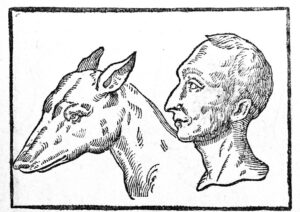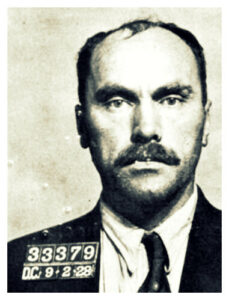Chapter 2: Origins of Criminal Behavior – Biological and Psychological
As mentioned in Chapter 1, deviancy and deviant behavior violates society’s expectations, rules, and laws that govern it. Again, not all deviancy is criminal. Some is just bizarre or unacceptable behavior in that environment.

This is referred to as goodness-of-fit. Essentially, deviancy depends on the environment in which it occurs.
There are also societal expectations placed on members of our society. However, deviancy can depend on the group with which you are in the presence of. This can differ culturally between the United States and outside of the U.S. will be discussed in later chapters.
Deviancy, or what is considered to be deviant behavior can take many forms. For example, certain religions can be considered deviant An example of this may be practicing religion that are not wholly Christian-based. Take the religion of Wicca. The group of practicing Wiccans is considered a coven. This religion is polytheistic in that, both Mother Earth and Father Sky are worshipped. A pentagram is used as the predominant symbol of their religion, comparable to Christians using a cross. To many, a pentagram is considered satanic and evil. So, someone outside of Wicca looking in, may think that this religion is demonic and the practitioners of it are summoning evil. When in fact, the coven is merely worshiping different deities while using a different symbol to define their religion. Taking this into account, someone paying homage to a deity or deities outside of the aforementioned religious groups could be considered deviant behavior. According to Pew Research (2023) Christianity is the most prominent religion in the United States, followed by Evangelical Protestant, Catholic, and ‘Unaffiliated. See their interactive data via this link: Pew Research: Religious Landscape Study.
Another example is sexual preferences. Sexual proclivities or sexual preference that one person supports could be deviant to another. This could include fetish behavior, asexuality, homosexuality, pansexuality, bisexuality, etc. in lieu of heterosexuality. Individuals may find that anyone who does not follow the specific sexual expectation of ‘union between male/female’ as deviant.
A final example to share is related to eating disorders. Sufferers from anorexia nervosa (AN) and bulimia nervosa (BN) is considered deviant behavior. Both of these types of disorders are usually focused on anxious and/or depressive symptoms. Individuals suffering from this will restrict food intake (anorexia). This disorder is fraught with fear of weight gain and obsessive fear of being ‘fat’. Bulimics will practice binging and purging. Where the suffer consumes copious amounts of unhealthy food, feels the guilt of this, and attempts to diminish the caloric intake by expelling the food via vomiting, laxative abuse, or both. “Individuals with AN and BN are consistently characterized by perfectionism, obsessive-compulsiveness, and dysphoric mood. Individuals with AN tend to have high constraint, constriction of affect and emotional expressiveness, anhedonia and asceticism, whereas individuals with BN tend to be more impulsive and sensation seeking. Such symptoms often begin in childhood” (Kaye, 2008). The AN and BN suffers attempt to please and/or are deluded in thought believing that society, family, friends, or peers demand the expectation of being visually and physically perfect.
Origins of deviant behavior
Human biology is the study of—well humans. This includes human development, our evolution, genetics, anthropology, and anatomy and physiology. This is a broad topic with multiple avenues we could travel. So, lets narrow things down a bit and focus on psychological biology of adults and how it connects to deviant behaviors.

When babies enter this world, they are not born with personality disorders that may befall them as they grow up. Newborn babies still have their innocence and have not been scarred emotionally or mentally by their caregivers or other negative happenings of life. But they are biological products of their mother and father. Have you ever been told that “you act just like your mother” or “you have your father’s personality”—of course, this could be good, bad, or indifferent. Especially, if there are genetic components that can impede normal development and/or potentially lead to deviance.
It Begins Young
For infants and children who have a positive and healthy relationship with their maternal figure, he/she will learn to give and receive love. A child who grows up and turns to criminal deviancy, potentially had no mother figure or a mother who was angry, distant, absentee, negligent, and/or abusive. On the other side of the coin, children lacking paternal support, love, and affection may offer similar undesirable behaviors as they would with a maternal figure regardless of the child residing in a 2-parent household or a 1-parent where the father is the primary and mother is absentee.
In fact, a child being raised in this situation as young as 2-years old may start showing aggression. By 3-years old, aggression may become the common reaction when provoked. This aggression will continue to increase unless appropriate intervention occurs.
Without appropriate intervention, the child will not know what behavior socially acceptable and what society’s requirements for civilized interaction is. By school age, the child will realize he is different from the other children and may use aggression to compensate for feelings of ostracization and diminished self-worth. By ages 8-12, a child will form strong feelings for those loved and those hated in their life. Children who are raised in chaotic families, broken homes, dysfunctional families, and lower income families are at risk for deviant behaviors.
To say that lower income families are at risk for producing a deviant child is for two (2) reasons:
- The residential area that they reside is generally low income and unfortunately low-income areas is generally where criminals live.
- The second reason is the child is being raised by a single mother who has to work to support her family. Thus, the child is left to his/her own devices and essentially raises themselves or the neighborhood raises them.
Most teenagers are impulsive as their brain has not matured enough to realize actions have consequences. Incidents of violence in the family home witnessed by a child can desensitize them and cause belief that this behavior is acceptable outside of the home.
Adults
There were several theorists who felt that deviancy and/or those would potentially commit same could be identified externally—by merely observing their body shape and/or facial shape. Let’s focus on two of the more prominent theorists: Cesare Lombroso and William H. Sheldon.
Cesare Lombroso
 Cesare Lombroso (1835-1909) focused on several aspects of criminality as well as psychiatry. He was a proponent of eugenics and the founding father of the Italian school of criminology. APA calls this . He believed that there was a correlation between hereditary and criminal deviancy. Lombroso believed that deviant behaviors could be attributed to misshapen skulls, facial structure, and genetic makeup. In fact, taking the theory of eugenics deemed people could be born criminal specifically based on how they looked (e.g head and facial structure) and claimed that these individuals could be easily identified by their ‘atavistic’ or primitive facial features.
Cesare Lombroso (1835-1909) focused on several aspects of criminality as well as psychiatry. He was a proponent of eugenics and the founding father of the Italian school of criminology. APA calls this . He believed that there was a correlation between hereditary and criminal deviancy. Lombroso believed that deviant behaviors could be attributed to misshapen skulls, facial structure, and genetic makeup. In fact, taking the theory of eugenics deemed people could be born criminal specifically based on how they looked (e.g head and facial structure) and claimed that these individuals could be easily identified by their ‘atavistic’ or primitive facial features.
According to Simply Psychology, the following were examples of atavistic features to look for:
- Features of a thief: expressive face, manual dexterity, and small darting eyes

“‘I precursori di C. Lombroso…'” by Biblioteca Rector Machado y Nuñez is marked with Public Domain Mark 1.0. - Features of a murder: cold glassy stare, bloodshot eyes, large pronounced nose comparable to that of a bird of prey
- Features of a sex offender: thick lips and protruding ears
- Features of female offenders: short, wrinkled skin, dark hair, lustful, immodest, microcephalic or possessing a small than normal skull. Women with a large protruding lower jaw were more vicious than males with the same features.
Learn more about current research on Lombroso ideas here: Cultural Expertise in Italian Criminal Justice: From Criminal Anthropology to Anthropological Expert Witnessing (Ziliotto, 2019)
In taking atavistic features into consideration, Lombroso stated those who were born criminals could be classified as criminals by passion, criminal epileptics, occasional criminals, and moral imbeciles.
“Thus were explained anatomically the enormous jaws, high cheek bones, prominent superciliary arches, solitary lines in the palms, extreme size of the orbits, handle shaped or sessile ears found in criminals, savages and apes, insensibility to pain, extremely acute sight, tattooing, excessive idleness, love of orgies and the irresistible craving for evil for its own sake, the desire not only to extinguish life in the victim, but to mutilate the corpse, tear its flesh, and drink its blood.” (History Extra, 2023)
William H. Sheldon
William H. Sheldon (1898-1977) was an American psychologist who followed some of Lombardo’s theories that deviancy can be noticed by merely looking at someone. He developed a somatotype to determine personality based on an individual’s body type. According to Britannica, there were three body types:

- Mesomorphs were fit, athletically built with an aggressive, no inhibitions, assertive personality, active and energetic lifestyle. The head was large, broad shoulders, prominent chest, muscular arms and legs, low body fat.
- Endomorphs were overweight with a soft, round build had a ‘viscerotonic’ personality meaning there were extroverts, relaxed, and comfortable around others. The head of this individual was perfectly round with a bulbus body, protruding abdomen, short arms, short legs. However, these individuals possessed thin wrists and ankles.
- Ectomorphs were lacking muscle, underweight or a thin build, possessed an introverted, thoughtful, or sensitive personality with inhibitions. Features included a thin face, large forehead, small weak chin, small chest, thin extremities.
Brain
Select each of the hot spots below to learn more about each lobe of the brain and their respective functioning.
Our brain controls near every aspect of our being and is the most complex of our organs. It not only controls the movement of our bodies, but it also controls our mood, behavior, motor skills, emotions, thoughts, memory, touch, sight, and much more. When our bodies are irregular our brains can be impacted in a bad way. Our feelings such as empathy, sympathy, fears, anger, happiness, frustration, loneliness, etc. can be impacted. Should there be something wrong with our monoamine neurotransmitters (ex. Serotonin, Dopamine) can lead to deviant behaviors.
Juvenile Delinquency
References:
Britannica (2023). William Sheldon. Retrieved on September 13, 2023 from https://www.britannica.com/biography/William-Sheldon
Brookes, E. (2023). Cesare Lombroso: Theory of crime, criminal man, and atavism. Simply Psychology. Retrieved on September 13, 2023 from https://www.simplypsychology.org/lombroso-theory-of-crime-criminal-man-and-atavism.html
Cleveland Clinic (2022). Serotonin. Retrieved on September 13, 2023 from https://my.clevelandclinic.org/health/articles/22572-serotonin#:~:text=Serotonin%20plays%20several%20roles%20in,mania%20and%20other%20health%20conditions
History Extra (2023). The “born criminal”? Lombroso and the origins of modern criminology. Retrieved on September 13, 2023 from https://www.historyextra.com/period/victorian/the-born-criminal-lombroso-and-the-origins-of-modern-criminology/
University of Queensland (2023). The lobes of the brain. Retrieved on September 13, 2023 from https://qbi.uq.edu.au/brain/brain-anatomy/lobes-brain
Ziliotto, A. (2019). Cultural expertise in Italian criminal justice: From criminal anthropology to anthropological expert witnessing. Laws, 8(2). https://doi.org/10.3390/laws8020013
an early positivist approach to criminology (see positivist criminology) associated with the theories of Italian criminologist and psychiatrist Cesare Lombroso (1835–1909). It embraced the notion of the “born criminal” or criminal type, based on the belief that criminals had certain physical characteristics (e.g., sloping forehead, large ears) that distinguished them from noncriminals. Lombroso identified these characteristics as “atavistic anomalies… that bring man closer to the inferior animals,” then developed a hypothesis that linked delinquency to constitutional anomalies and attributed the primal cause of crime to hereditary flaws.

